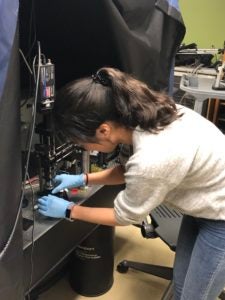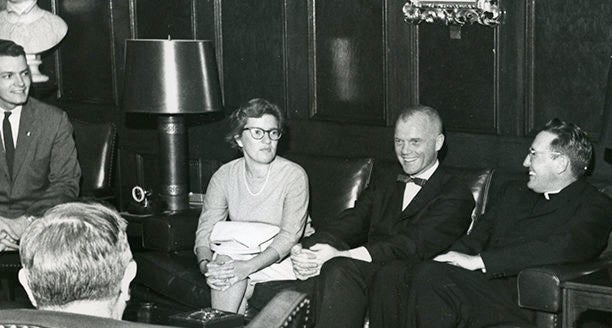Observatory Named for Georgetown Physicist Who Encourages Next Generation of Women in Science
Sarah Jiang (C’21) says she’s thrilled that the National Science Foundation chose to name a telescope designed to conduct “a vast astronomical survey” after Vera Rubin (G’54), the renowned Georgetown alumna and physicist.
After receiving her Ph.D. from Georgetown in 1954, Rubin subsequently worked at the university as a researcher and professor. She went on to work at the Carnegie Institution, where she discovered the first evidence of dark matter.
An Impactful Legacy
Jiang, a student researcher in the Department of Physics and a member of the Georgetown Astronomical Society, says that working in science can be challenging, but she is motivated by women like Rubin who have blazed the trail for others.

Wide-reach of Physics: Jiang researching the development of polymer nanoparticles for treating acute kidney injury
“Women like Vera Rubin, especially in male-dominated fields like physics, are a really important reminder to us that we can do it, that we’re just as smart and capable as men and we can someday rise to the same heights,” Jiang says. “For the groundbreaking discovery of dark matter to have been made by … a woman is incredibly special and important to me and I’m sure other women in physics.”
The Vera C. Rubin Observatory, previously known as the Large Synoptic Survey Telescope, is under construction in Chile and will conduct an astronomical survey called the Legacy Survey of Space and Time.
Don’t STEM the Tide
Jiang says that Rubin’s accomplishments encourage her to continue following her passion.
“I decided to be a physics major because I love science, especially space science, and I wanted to be a part of the growing field of astrophysics and space science,” Jiang says. “Being a woman in STEM hasn’t been easy – I think women in STEM tend to doubt themselves more, question their ability and skill and wonder if they’re cut out for it after all.”

Readying samples for testing
Rubin did not receive the Nobel Prize for her groundbreaking discovery of the existence of dark matter, though the three male physicists who identified dark energy did. But the Georgetown alumna overcame barriers built around her gender more than once.
“When Rubin finally gained access to the 200-inch Palomar telescope in California, she found that there was no women’s restroom there,” says Dennis Overbye, in his New York Times article about Rubin. “So she taped an outline of a woman’s skirt over the image of the man on the door, turning it into a ladies’ room. Now she has an observatory of her own.”
He also wrote that Rubin is only the fourth woman in the world to have had an astronomical facility named after her.
A Fitting Honor
“This is a fitting honor for Vera’s trailblazing career,” says Jeffrey Urbach, physics department chair. “The Vera Rubin Observatory will enable us to see and understand much more of our universe, just as Vera’s work helped reveal nature’s deepest mysteries.”
By highlighting Vera, Urbach says the National Science Foundation is providing an “inspiration to us all by spotlighting her pioneering role in breaking down barriers to women in science.”
“At Georgetown in the 1970s, with its commitment to cura personalis, Vera found a place where she could be fully supported in her Ph.D. research and her first faculty position, at a time when such support could not be taken for granted, he says. “We’re very proud that her illustrious career started on the Hilltop!”
-by Shelby Roller (G’19)
